A Tutorial on Bayesian Belief Networks
Mark L Krieg
Surveillance Systems Division
Electronics and Surveillance Research Laboratory
DSTO{TN{0403
ABSTRACT
This tutorial provides an overview of Bayesian belief networks. The sub-
ject is introduced through a discussion on probabilistic models that covers
probability language, dependency models, graphical representations of mod-
els, and belief networks as a particular representation of probabilistic models.
The general class of causal belief networks is presented, and the concept of
d-separation and its relationship with independence in probabilistic models is
introduced. This leads to a description of Bayesian belief networks as a speciflc
class of causal belief networks, with detailed discussion on belief propagation
and practical network design. The target recognition problem is presented as
an example of the application of Bayesian belief networks to a real problem,
and the tutorial concludes with a brief summary of Bayesian belief networks.
APPROVED FOR PUBLIC RELEASE
�
DSTO{TN{0403
Published by
DSTO Electronics and Surveillance Research Laboratory
PO Box 1500
Edinburgh, South Australia, Australia 5111
Telephone:
Facsimile:
(08) 8259 5555
(08) 8259 6567
c Commonwealth of Australia 2001
AR No. 012{084
December, 2001
APPROVED FOR PUBLIC RELEASE
ii
�
A Tutorial on Bayesian Belief Networks
DSTO{TN{0403
EXECUTIVE SUMMARY
A Bayesian belief network is a graphical representation of a probabilistic dependency
model. It consists of a set of interconnected nodes, where each node represents a variable in
the dependency model and the connecting arcs represent the causal relationships between
these variables. Each node or variable may take one of a number of possible states or
values. The belief in, or certainty of, each of these states is determined from the belief in
each possible state of every node directly connected to it and its relationship with each
of these nodes. The belief in each state of a node is updated whenever the belief in each
state of any directly connected node changes.
Bayesian belief networks are particularly suited to the target recognition problem,
where the category, identity and class of a target track are to be determined. Each of
these three track attributes may be modelled by a hypothesis node, in which each state
represents a difierent hypothesis. Evidence, such as Identiflcation Friend or Foe (IFF)
reports, Electronic Support (ES) data and track dynamics, is applied to the network
through evidence nodes. On receipt of evidence, the belief in the state of the evidence node
changes, causing changes in the belief of all nodes to ripple through the entire network,
including the hypothesis nodes.
In this way, the evidence updates the beliefs for each
category, identity and class, and possibly the most likely state of each.
iii
�
DSTO{TN{0403
iv
�
DSTO{TN{0403
Author
Mark L Krieg
Surveillance Systems Division
Mark Krieg joined the Defence Science and Technology Organ-
isation (DSTO) Australia in 1976 as a radio apprentice. From
1981 until 1987 he worked as a technical o–cer in the Commu-
nications and Electronic Engineering Division in the areas of
communication networks, and control and instrumentation.
Dr Krieg obtained his BE(Elect) from the University of Ade-
laide in 1992 and his PhD from the same institution in 1998. He
joined the Microwave Radar Division in 1992 where he worked
in the radar signal and data processing area. He is currently a
Senior Research Scientist attached to the Tracking and Sensor
Fusion group of the Surveillance Systems Division, where he
is pursuing research into multi-sensor tracking and fusion for
defence applications.
v
�
DSTO{TN{0403
vi
�
DSTO{TN{0403
Contents
Glossary
Abbreviations and Acronyms
Symbols
1
Introduction
2 Probabilistic Models
2.1
Probability Language
. . . . . . . . . . . . . . . . . . . . . . . . . . . . .
2.2 Dependency Models . . . . . . . . . . . . . . . . . . . . . . . . . . . . . .
2.3 Graphical Representation of Dependency Models . . . . . . . . . . . . . .
2.4
Belief Networks . . . . . . . . . . . . . . . . . . . . . . . . . . . . . . . . .
3 Causal Belief Networks
3.1 Dependencies in Causal Networks
. . . . . . . . . . . . . . . . . . . . . .
4 Bayesian Belief Networks
5 Propagation in Bayesian Belief Networks
xi
xiv
xiv
1
2
3
4
4
5
6
7
10
12
5.1 Causal Trees
. . . . . . . . . . . . . . . . . . . . . . . . . . . . . . . . . . 13
5.2 Causal Polytrees . . . . . . . . . . . . . . . . . . . . . . . . . . . . . . . . 15
5.3
Practical Methods . . . . . . . . . . . . . . . . . . . . . . . . . . . . . . . 16
5.3.1
5.3.2
5.3.3
5.3.4
Clustering . . . . . . . . . . . . . . . . . . . . . . . . . . . . . . . 17
Conditioning . . . . . . . . . . . . . . . . . . . . . . . . . . . . . . 18
Stochastic Simulation . . . . . . . . . . . . . . . . . . . . . . . . . 19
The Noisy-Or-Gate . . . . . . . . . . . . . . . . . . . . . . . . . . 20
6 Building Networks
22
6.1 Choosing the Structure
. . . . . . . . . . . . . . . . . . . . . . . . . . . . 23
6.2 The Probabilities . . . . . . . . . . . . . . . . . . . . . . . . . . . . . . . . 24
6.3 Other Design Issues
. . . . . . . . . . . . . . . . . . . . . . . . . . . . . . 24
6.3.1
6.3.2
6.3.3
6.3.4
Undirected Relations . . . . . . . . . . . . . . . . . . . . . . . . . 25
Divorcing . . . . . . . . . . . . . . . . . . . . . . . . . . . . . . . 25
Noisy Or . . . . . . . . . . . . . . . . . . . . . . . . . . . . . . . . 26
Causal Independence . . . . . . . . . . . . . . . . . . . . . . . . . 26
vii
�
DSTO{TN{0403
7 Target Recognition Application
8
Summary
References
Appendices
A
Axioms for Dependency Models
B Markov Networks
26
27
28
30
35
B.1 Markov Trees . . . . . . . . . . . . . . . . . . . . . . . . . . . . . . . . . . . . 36
B.2
Join Trees . . . . . . . . . . . . . . . . . . . . . . . . . . . . . . . . . . . . . . 37
C
Belief Table Algebra
39
C.1 Multiplication and Division . . . . . . . . . . . . . . . . . . . . . . . . . . . . 39
C.2 Marginalisation . . . . . . . . . . . . . . . . . . . . . . . . . . . . . . . . . . . 40
D
Learning
41
D.1
Batch Learning . . . . . . . . . . . . . . . . . . . . . . . . . . . . . . . . . . . 41
D.2 Adaptation . . . . . . . . . . . . . . . . . . . . . . . . . . . . . . . . . . . . . 42
E
Comparison with Decision Theory
Figures
44
8
9
9
3.1
3.2
3.3
5.1
5.2
5.3
5.4
5.5
5.6
5.7
A serial belief network connection . . . . . . . . . . . . . . . . . . . . . . . . .
A diverging belief network connection . . . . . . . . . . . . . . . . . . . . . .
A converging belief network connection . . . . . . . . . . . . . . . . . . . . . .
Bayesian belief network for track identiflcation from platform data . . . . . . 12
Propagation in a chain network . . . . . . . . . . . . . . . . . . . . . . . . . . 14
Propagation in a tree network . . . . . . . . . . . . . . . . . . . . . . . . . . . 14
Propagation in a causal polytree network . . . . . . . . . . . . . . . . . . . . 15
Simple clustering example . . . . . . . . . . . . . . . . . . . . . . . . . . . . . 17
Clustering using join trees . . . . . . . . . . . . . . . . . . . . . . . . . . . . . 18
Using conditioning to remove loops . . . . . . . . . . . . . . . . . . . . . . . . 19
5.8 Modelling disjunctive interactions using the noisy-OR-gate . . . . . . . . . . . 21
viii
�
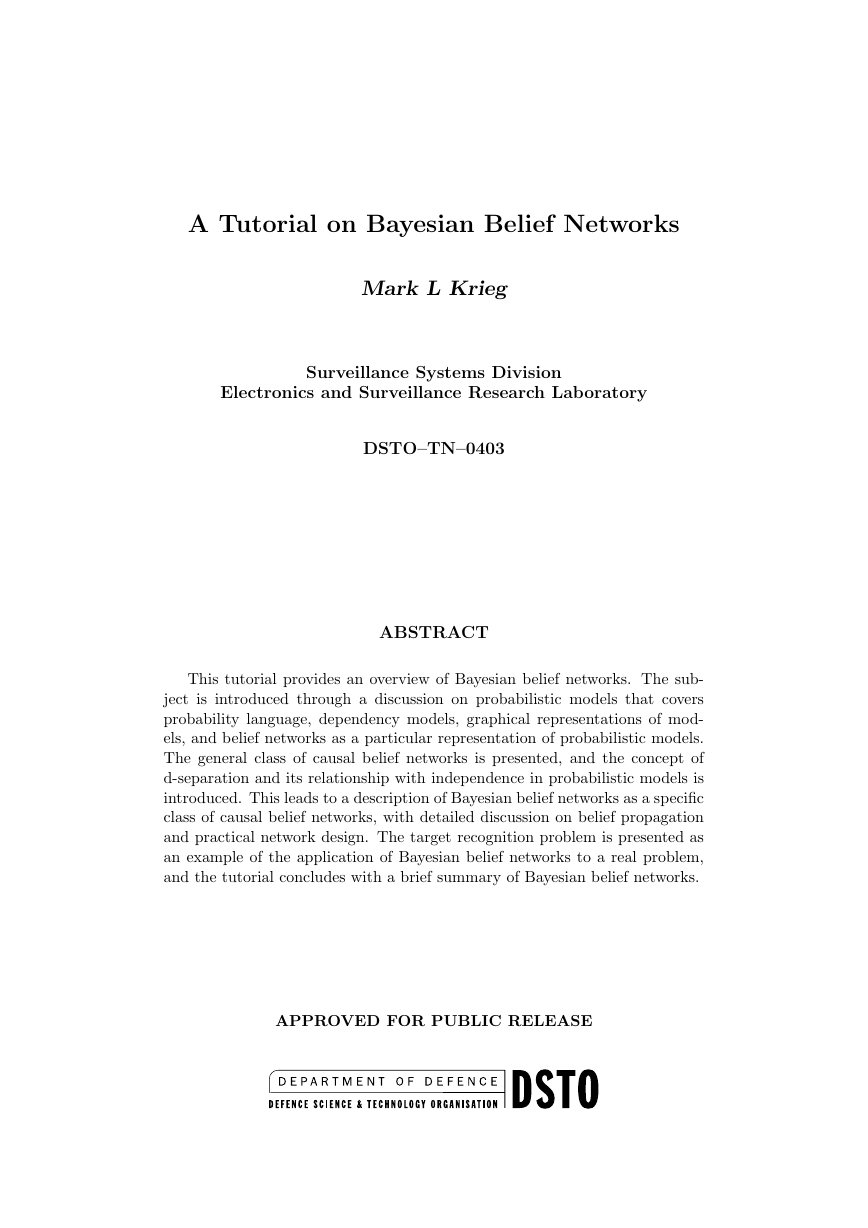

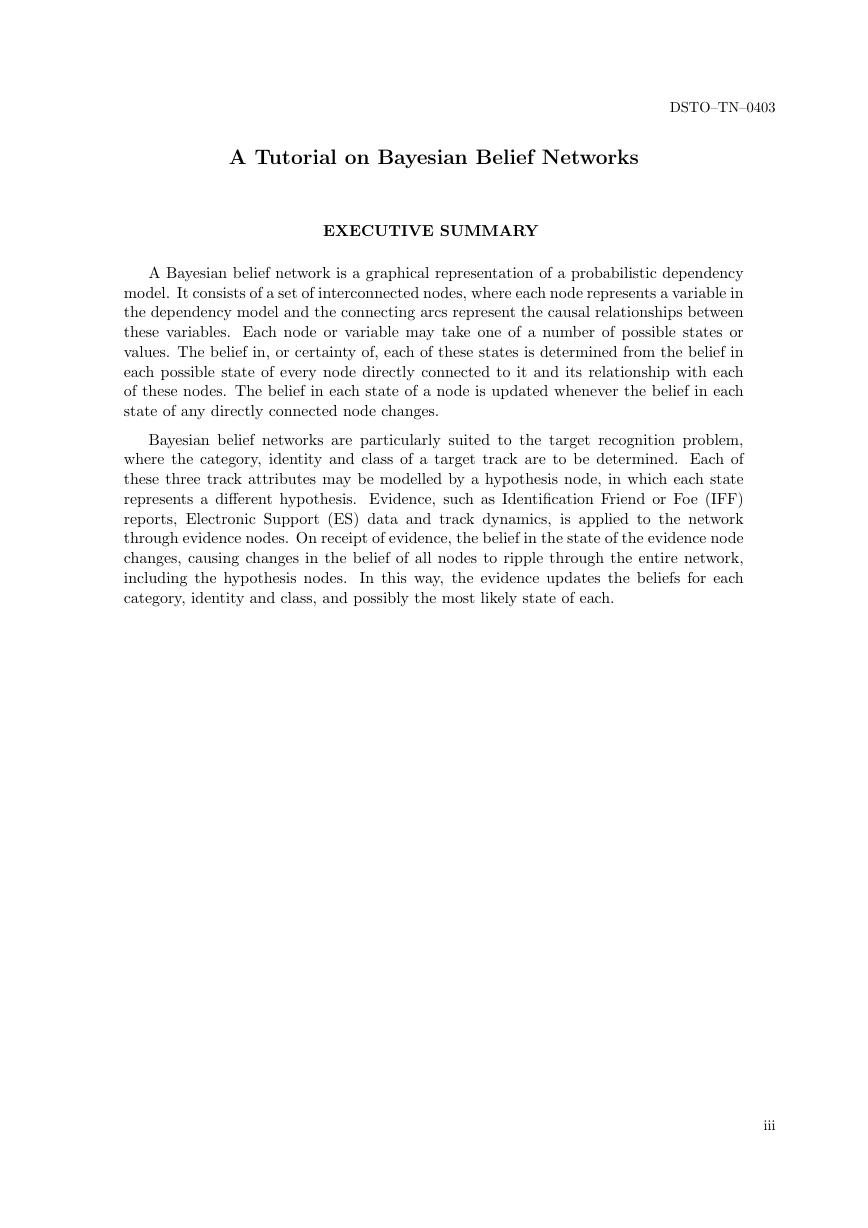

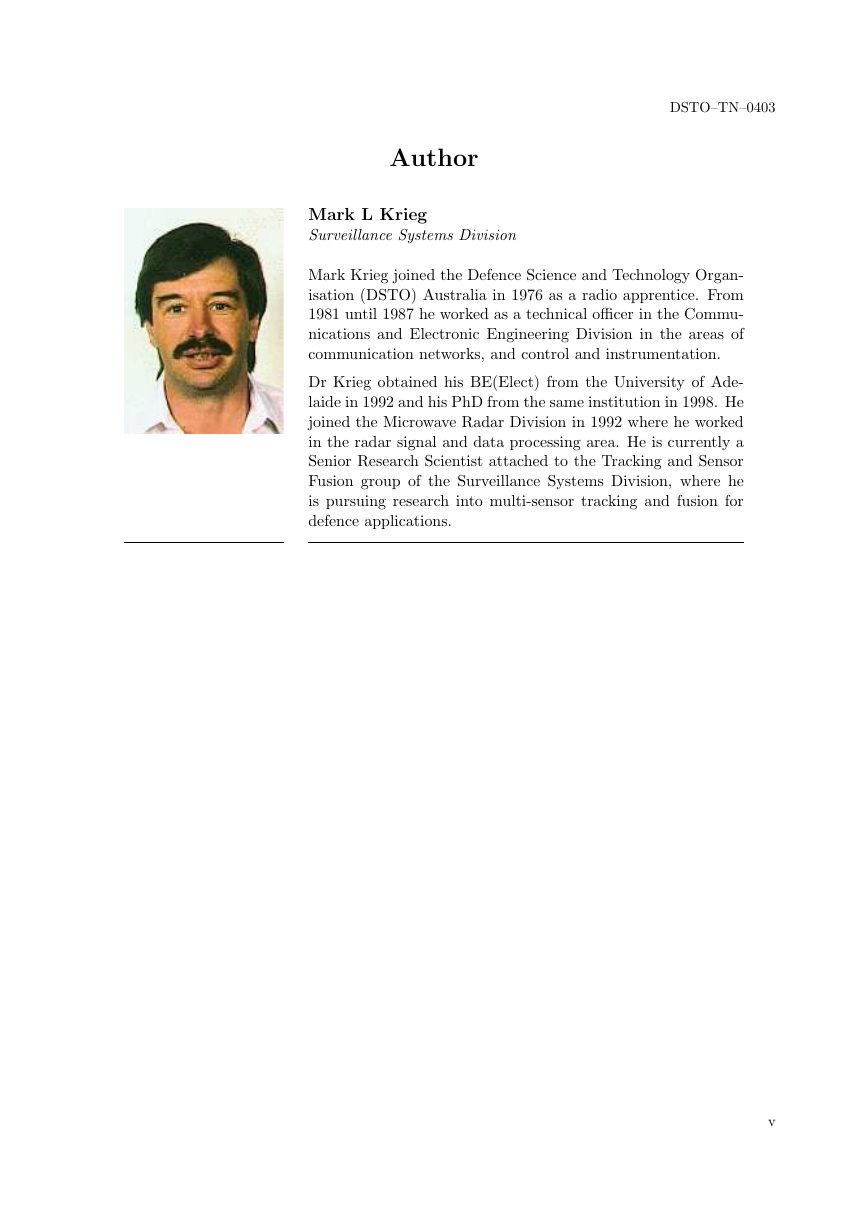

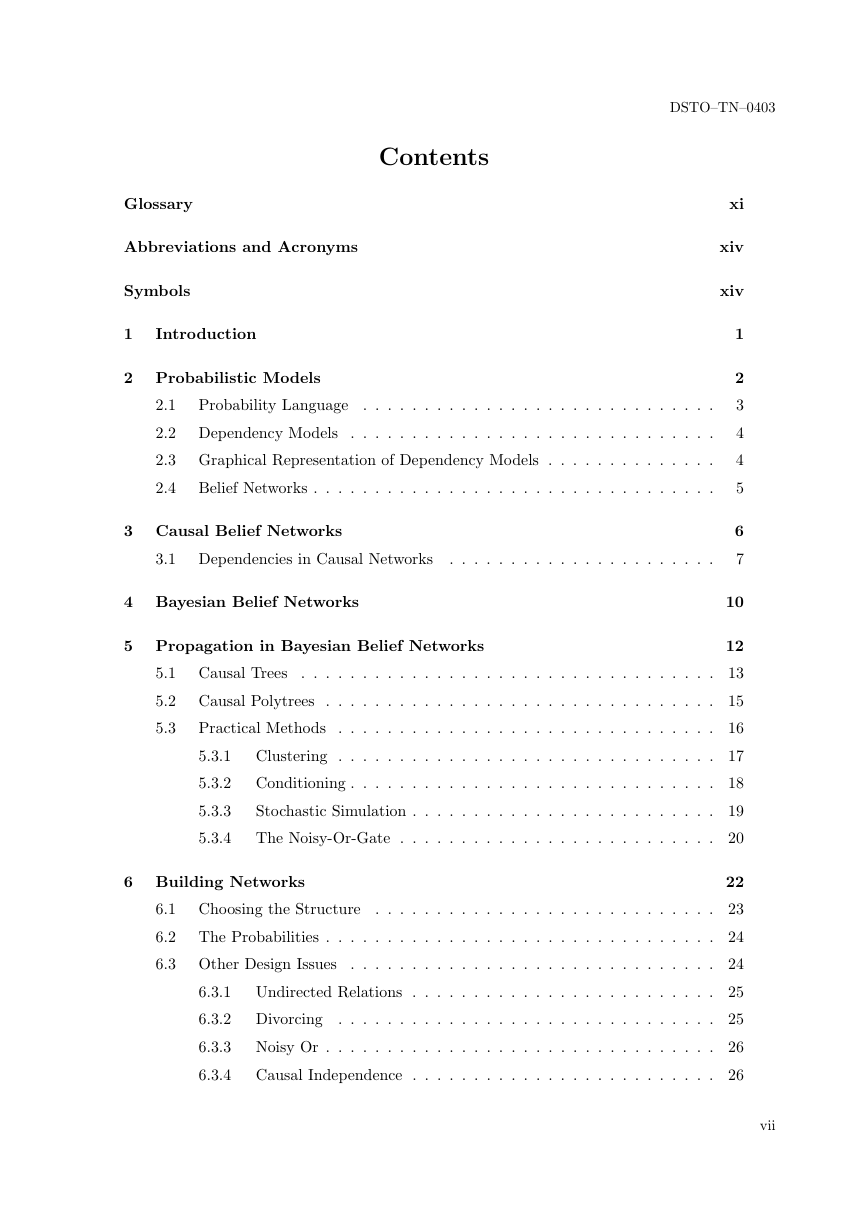
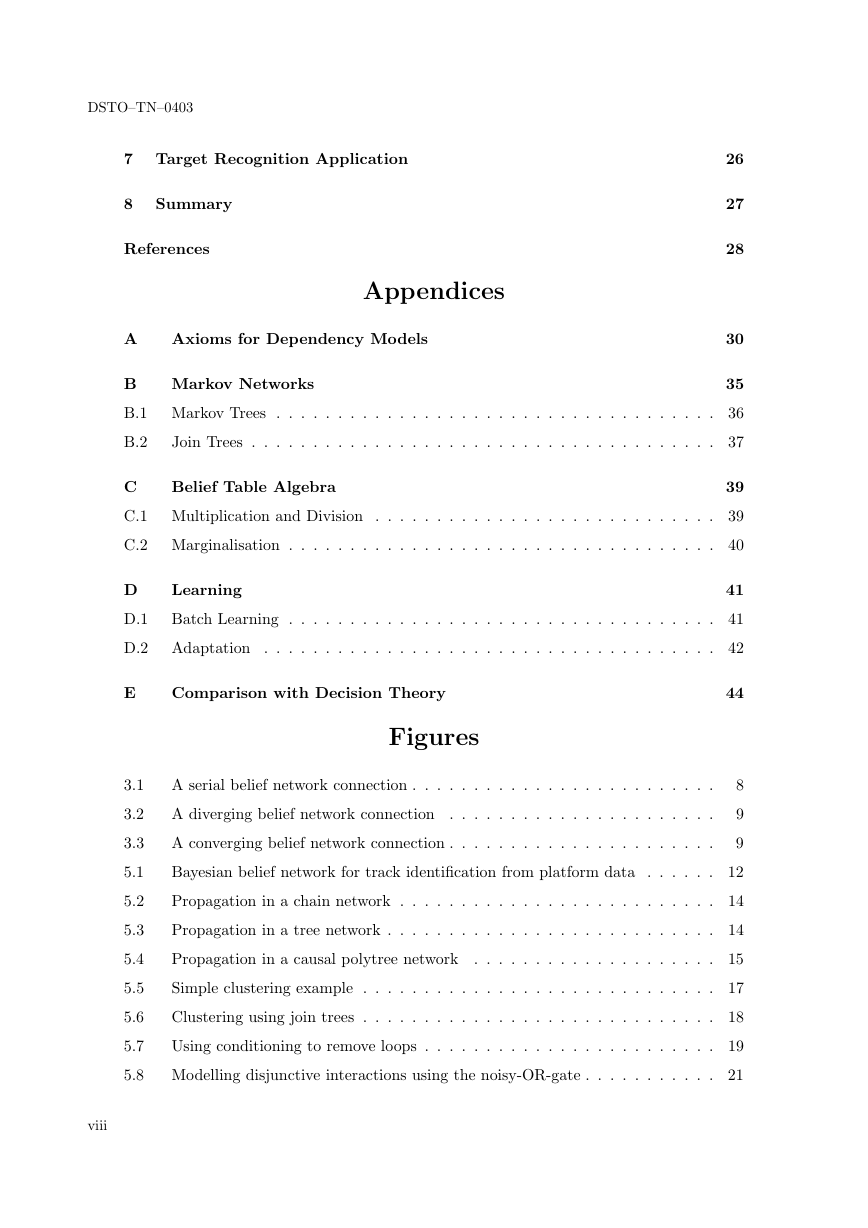








 2023年江西萍乡中考道德与法治真题及答案.doc
2023年江西萍乡中考道德与法治真题及答案.doc 2012年重庆南川中考生物真题及答案.doc
2012年重庆南川中考生物真题及答案.doc 2013年江西师范大学地理学综合及文艺理论基础考研真题.doc
2013年江西师范大学地理学综合及文艺理论基础考研真题.doc 2020年四川甘孜小升初语文真题及答案I卷.doc
2020年四川甘孜小升初语文真题及答案I卷.doc 2020年注册岩土工程师专业基础考试真题及答案.doc
2020年注册岩土工程师专业基础考试真题及答案.doc 2023-2024学年福建省厦门市九年级上学期数学月考试题及答案.doc
2023-2024学年福建省厦门市九年级上学期数学月考试题及答案.doc 2021-2022学年辽宁省沈阳市大东区九年级上学期语文期末试题及答案.doc
2021-2022学年辽宁省沈阳市大东区九年级上学期语文期末试题及答案.doc 2022-2023学年北京东城区初三第一学期物理期末试卷及答案.doc
2022-2023学年北京东城区初三第一学期物理期末试卷及答案.doc 2018上半年江西教师资格初中地理学科知识与教学能力真题及答案.doc
2018上半年江西教师资格初中地理学科知识与教学能力真题及答案.doc 2012年河北国家公务员申论考试真题及答案-省级.doc
2012年河北国家公务员申论考试真题及答案-省级.doc 2020-2021学年江苏省扬州市江都区邵樊片九年级上学期数学第一次质量检测试题及答案.doc
2020-2021学年江苏省扬州市江都区邵樊片九年级上学期数学第一次质量检测试题及答案.doc 2022下半年黑龙江教师资格证中学综合素质真题及答案.doc
2022下半年黑龙江教师资格证中学综合素质真题及答案.doc